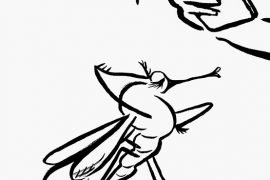There are many Inuit legends about the northern lights. Westerners,...

The audiovisual sector has a motto that will always prevail:...

“Science is alive and it’s part of culture. Science is...

There is no need, anymore, to go to Silicon Valley...

The Catalan seed company invoices 64% of turnover through exports,...

The first session of the cycle on the regatta organized...

Its spin-off, Peptomyc, is immersed in its second clinical trial,...
Everything seems to indicate that agriculture and cattle-raising stand on...

Then, Agbar becomes the first large corporation that restores its...

The importance of the logistics and transport industry is unquestionable....

Música clásica sobre la arena de la playa en dos...

The first session of the cycle on the regatta organized...

The hospital's managing director, Manel del Castillo, and the pharmaceutical...

Generalitat y Ayuntamiento impulsarán dos equipamientos de 'Casa de les...

Leticia Beleta, director of Alexion Pharmaceuticals in Spain and Portugal,...

We all have a friend who never leaves the Gràcia...

Barcelona director opts for Best International Film with 'La sociedad...

The hotel and industrial sectors softened the market's decline last...

The technology company, with a workforce of 35 employees and...

“The women of yesteryear were strong and had to fight...
[dropcap letter=”I”]
t is hard to determine what the primal seed is of our mind’s image of childbirth. Hundreds of scenes from films and series are mixed in with stories heard at random in postprandial conversations, illustrations of books on nature, testimonials by celebrities in magazines and mothers’ and grandmothers’ re-runs of old battles. In that abstract mental movie there is always sweat and screams, boiling water, clean towels and babies at birth, all shot from four different angles. Sometimes even God’s voice off screen, condemning Eve to “give birth to her children” (Genesis) for having dared to steal an apple from Him. In the end, an epic mental pulp, empty of practical information, which as it is sipped in throughout life, leaves an intense aftertaste of fear. Fear of pain, fear of the unknown. Something similar to the choking feeling in your throat when those two lines appear and you realise that, if nothing goes astray, you’re going to be the next to give birth.
Despite having access to information and being surrounded by other women who have already gone through the predicament, only when you get pregnant do you realise that you do not have the faintest idea what delivery is really about. What is the pain like? What does it feel like? How long does it last, where in your body does it hurt, how intensely? Your first reaction is to turn to Google while you wonder how it is possible that, being something to do with your own body, you know nothing at all about it. First of all, because our phallocentric education system omits everything that affects just women. In addition, we pay less attention to what does not directly involve us, so we are not interested in the subject until it is our turn to conjugate the verb beget in the first person. The Catholic tradition also weighs in; the modesty and shame associated with talking about intimate aspects act as censors of the story telling between past and future birth-givers. The former tend to omit any specific description of what happened to their body or around their genital area as if it were a compendium of obscene details to be ashamed of, and the latter, most of whom accrue tons of extremely specific questions about those particular ravages, modestly refrain from asking so as not to be offensive.
Nor does the mystification of the idea of childbirth better help to communicate the process. The conception of childbirth as “the miracle of life” or as “an experience transforming that of being a woman” tends to strip the narrative of all its physical and worldly details. It is true that one’s karmic level plummets upon learning that, during dilation, your body may decide to vomit everything, down to the very last pap, or that your baby may be born before, during or after defecation. It is not a matter of frightening the future birth-givers with horror stories about excruciating pain—if it were really unbearable, humanity would be extinct by now—but rather to narrate the facts as they were, without minimising or exaggerating them. The trend, on the other hand, is another.
The article Miedo al parto y narrativas intergeneracionales: Una aproximación desde la antropología (Fear of childbirth and intergenerational narratives: an anthropological approach — Laura Cardús, University of Barcelona, 2015) analyses and describes this phenomenon in detail. “Oral transmission between women on the experience of birth is situated simultaneously at opposing poles: on one hand, it is difficult to find spaces where truthful information about the process is shared, while on the other, when these spaces are available, their use is intense.” In this sense, one of the women interviewed for the research says “If you build a story of pain and fear that you have overcome, you make yourself out to be a super-hero, but you are building absolute fear in the other” (Isabella, oral testimony).
Indeed, this is a common phenomenon: it is not uncommon to hear a newborn’s mother speak of her experience of childbirth as if she had survived war, or of motherhood as something only those who have experienced it can understand. Placing that label on childbirth contributes to the perpetuation of obscurantism around it that is a breeding ground for fear, tension and insecurity among pregnant women, three factors that do not precisely help to control pain in childbirth.
ESCAPE OR EMPOWERMENT: THE ROLE OF MEDICALISATION
Despite WHO’s repeated recommendations to reduce the number of caesarean sections and limit them only to deliveries where it is medically necessary, Spain remains one of the countries in Europe where it is practiced most, with over a quarter of all deliveries being caesarean. This fact is partly due to the convenience offered by the scheduling of deliveries, but also to the social acceptance of the procedure, considered by many women as the most comfortable way to have a baby. For them, a caesarean section is the best option to avoid labour pains, without taking into account the implicit risks associated with surgical procedures of this kind. Extreme medicalisation has thus become a mental beeline to escape the fear of pain. Another habitual antidote to terror is to develop an idealised and uninformed image of the birth you wish to experience. This Disney-channelisation can help to face the moment with greater calm but it will most likely end up causing frustration and anxiety if, as is usual, unforeseen events arise and the delivery cannot follow the idealised avenue.
Numerous studies have shown that fear and anxiety are factors in amplifying the perception of pain during childbirth. It is therefore essential to minimise them during pregnancy. How? By empowering mothers-to-be. By reinforcing their confidence in their physical and biological capacity to give birth. By dedramatising the process. By offering clear, direct, realistic information about what they will experience in their bodies and about the tools they have to face it, from breathing techniques to different kinds of anaesthesia. Information is power, and feeling you are in control of the situation reassures you, although it will not avoid the physical suffering inseparably associated with childbirth.
A PERSONAL NARRATIVE: MY PAIN AT CHILDBIRTH

There are women who dilate up to eight centimetres without flinching. Others suffer even before dilating. There are those who feel pain in the abdominal area and there are those who feel it in the lower back. Some stop in five hours and others, like me, need more than a day. The truth is that no birth is the same, nor are the narratives of pain identical. This is the narration of MY pain, as personal and non-transferable as my own experience of childbirth.
I experienced three types of pain. The first was like a very intense menstruation, concentrated over time. A pain that suddenly clenched my lower back, as if someone had grabbed each of my ovaries with an open hand and squeezed them tightly, counting to 60, and then releasing them, removing any trace of discomfort. The pain came and went in waves: it was intense and static, and a minute later it disappeared, freeing me of any discomfort as if it had never been there. Sometimes, the pain made me hold my breath, like when a wave rolls up on the beach and you spend a few seconds underwater. But, despite all this, it was a bearable pain at all times: I lived with it 14 hours at home, eating, writing and even cooking stuffed aubergines without using any pain relievers, beyond breathing, patience and the massages in the lower back my partner gave me.
The second kind of pain came suddenly and caught me off guard, because I thought I had already learned to control it. It was like a kind of giant whirlpool pulling my ovaries and the entire abdominal area down, as if a chasm had opened beneath me and a superhuman force wanted to tear off that part of my body while the rest of my trunk clung to life and tried to prevent it from happening. Intense, sharp and totally unexpected, it took my breath and I thought I was drowning. A minute and a half later it melted away, giving me a truce, but then the tremors and vomiting came and I began to feel very weak. I was afraid: I thought something was wrong because I did not know it was a normal reaction of the body. I chose to ask for an epidural, and four hours after the first strong contraction, I was administered it. In just fifteen minutes, the pain went from hurricane force to the category of slight discomfort.
Thirteen hours and nine centimetres of dilation later came the third pain. In Holland, where I live and where my daughter was born, anaesthesia is removed in this last phase of delivery so that the mother feels the contractions and perceives when to push—in Spain, this depends on the medics. This time, the pain rose by powers of ten, with the feeling that a percussion drill was trying to pierce me from within. The minutes were extremely long and it seemed to me that breathing and staying conscious was difficult. Fortunately, I discovered my own painkiller. In the first contraction, the midwife warned me that the pain would be reduced if I pushed. And she was absolutely right. When after several attempts I began to push rhythmically, the pain began to be contained during the intervals in which I was able to maintain the pressure. Each push was like a dam that stopped the tsunami and, despite the exhaustion and lack of oxygen, my will was more than strong enough to begin again. I wanted to stop the pain, I wanted it to end, I wanted my daughter to be born. I remember the exhaustion, the fire between my legs and a ruthless pressure, like the wind trying to blow out the window of an aeroplane. I also remember thinking that I did not give a damn if it blew out my whole life, just so long as my daughter would come out of me safe and sound. And, in the end, she came out. And all the subsequent pain and discomfort (suture, recovery, etc.) seemed like a real joke after that experience.
Childbirth is profoundly animal, as simple as it is unpredictable, and as painful as it is fleeting. Believing in being able to control it is fantasy, so the best you can do is exterminate expectations, dance with the present as it comes, and repeat over and over again that both the pain and the destruction at childbirth are temporary and that the only thing that remains is the life that ensues.
[dropcap letter=”I”]
t is hard to determine what the primal seed is of our mind’s image of childbirth. Hundreds of scenes from films and series are mixed in with stories heard at random in postprandial conversations, illustrations of books on nature, testimonials by celebrities in magazines and mothers’ and grandmothers’ re-runs of old battles. In that abstract mental movie there is always sweat and screams, boiling water, clean towels and babies at birth, all shot from four different angles. Sometimes even God’s voice off screen, condemning Eve to “give birth to her children” (Genesis) for having dared to steal an apple from Him. In the end, an epic mental pulp, empty of practical information, which as it is sipped in throughout life, leaves an intense aftertaste of fear. Fear of pain, fear of the unknown. Something similar to the choking feeling in your throat when those two lines appear and you realise that, if nothing goes astray, you’re going to be the next to give birth.
Despite having access to information and being surrounded by other women who have already gone through the predicament, only when you get pregnant do you realise that you do not have the faintest idea what delivery is really about. What is the pain like? What does it feel like? How long does it last, where in your body does it hurt, how intensely? Your first reaction is to turn to Google while you wonder how it is possible that, being something to do with your own body, you know nothing at all about it. First of all, because our phallocentric education system omits everything that affects just women. In addition, we pay less attention to what does not directly involve us, so we are not interested in the subject until it is our turn to conjugate the verb beget in the first person. The Catholic tradition also weighs in; the modesty and shame associated with talking about intimate aspects act as censors of the story telling between past and future birth-givers. The former tend to omit any specific description of what happened to their body or around their genital area as if it were a compendium of obscene details to be ashamed of, and the latter, most of whom accrue tons of extremely specific questions about those particular ravages, modestly refrain from asking so as not to be offensive.
Nor does the mystification of the idea of childbirth better help to communicate the process. The conception of childbirth as “the miracle of life” or as “an experience transforming that of being a woman” tends to strip the narrative of all its physical and worldly details. It is true that one’s karmic level plummets upon learning that, during dilation, your body may decide to vomit everything, down to the very last pap, or that your baby may be born before, during or after defecation. It is not a matter of frightening the future birth-givers with horror stories about excruciating pain—if it were really unbearable, humanity would be extinct by now—but rather to narrate the facts as they were, without minimising or exaggerating them. The trend, on the other hand, is another.
The article Miedo al parto y narrativas intergeneracionales: Una aproximación desde la antropología (Fear of childbirth and intergenerational narratives: an anthropological approach — Laura Cardús, University of Barcelona, 2015) analyses and describes this phenomenon in detail. “Oral transmission between women on the experience of birth is situated simultaneously at opposing poles: on one hand, it is difficult to find spaces where truthful information about the process is shared, while on the other, when these spaces are available, their use is intense.” In this sense, one of the women interviewed for the research says “If you build a story of pain and fear that you have overcome, you make yourself out to be a super-hero, but you are building absolute fear in the other” (Isabella, oral testimony).
Indeed, this is a common phenomenon: it is not uncommon to hear a newborn’s mother speak of her experience of childbirth as if she had survived war, or of motherhood as something only those who have experienced it can understand. Placing that label on childbirth contributes to the perpetuation of obscurantism around it that is a breeding ground for fear, tension and insecurity among pregnant women, three factors that do not precisely help to control pain in childbirth.
ESCAPE OR EMPOWERMENT: THE ROLE OF MEDICALISATION
Despite WHO’s repeated recommendations to reduce the number of caesarean sections and limit them only to deliveries where it is medically necessary, Spain remains one of the countries in Europe where it is practiced most, with over a quarter of all deliveries being caesarean. This fact is partly due to the convenience offered by the scheduling of deliveries, but also to the social acceptance of the procedure, considered by many women as the most comfortable way to have a baby. For them, a caesarean section is the best option to avoid labour pains, without taking into account the implicit risks associated with surgical procedures of this kind. Extreme medicalisation has thus become a mental beeline to escape the fear of pain. Another habitual antidote to terror is to develop an idealised and uninformed image of the birth you wish to experience. This Disney-channelisation can help to face the moment with greater calm but it will most likely end up causing frustration and anxiety if, as is usual, unforeseen events arise and the delivery cannot follow the idealised avenue.
Numerous studies have shown that fear and anxiety are factors in amplifying the perception of pain during childbirth. It is therefore essential to minimise them during pregnancy. How? By empowering mothers-to-be. By reinforcing their confidence in their physical and biological capacity to give birth. By dedramatising the process. By offering clear, direct, realistic information about what they will experience in their bodies and about the tools they have to face it, from breathing techniques to different kinds of anaesthesia. Information is power, and feeling you are in control of the situation reassures you, although it will not avoid the physical suffering inseparably associated with childbirth.
A PERSONAL NARRATIVE: MY PAIN AT CHILDBIRTH

There are women who dilate up to eight centimetres without flinching. Others suffer even before dilating. There are those who feel pain in the abdominal area and there are those who feel it in the lower back. Some stop in five hours and others, like me, need more than a day. The truth is that no birth is the same, nor are the narratives of pain identical. This is the narration of MY pain, as personal and non-transferable as my own experience of childbirth.
I experienced three types of pain. The first was like a very intense menstruation, concentrated over time. A pain that suddenly clenched my lower back, as if someone had grabbed each of my ovaries with an open hand and squeezed them tightly, counting to 60, and then releasing them, removing any trace of discomfort. The pain came and went in waves: it was intense and static, and a minute later it disappeared, freeing me of any discomfort as if it had never been there. Sometimes, the pain made me hold my breath, like when a wave rolls up on the beach and you spend a few seconds underwater. But, despite all this, it was a bearable pain at all times: I lived with it 14 hours at home, eating, writing and even cooking stuffed aubergines without using any pain relievers, beyond breathing, patience and the massages in the lower back my partner gave me.
The second kind of pain came suddenly and caught me off guard, because I thought I had already learned to control it. It was like a kind of giant whirlpool pulling my ovaries and the entire abdominal area down, as if a chasm had opened beneath me and a superhuman force wanted to tear off that part of my body while the rest of my trunk clung to life and tried to prevent it from happening. Intense, sharp and totally unexpected, it took my breath and I thought I was drowning. A minute and a half later it melted away, giving me a truce, but then the tremors and vomiting came and I began to feel very weak. I was afraid: I thought something was wrong because I did not know it was a normal reaction of the body. I chose to ask for an epidural, and four hours after the first strong contraction, I was administered it. In just fifteen minutes, the pain went from hurricane force to the category of slight discomfort.
Thirteen hours and nine centimetres of dilation later came the third pain. In Holland, where I live and where my daughter was born, anaesthesia is removed in this last phase of delivery so that the mother feels the contractions and perceives when to push—in Spain, this depends on the medics. This time, the pain rose by powers of ten, with the feeling that a percussion drill was trying to pierce me from within. The minutes were extremely long and it seemed to me that breathing and staying conscious was difficult. Fortunately, I discovered my own painkiller. In the first contraction, the midwife warned me that the pain would be reduced if I pushed. And she was absolutely right. When after several attempts I began to push rhythmically, the pain began to be contained during the intervals in which I was able to maintain the pressure. Each push was like a dam that stopped the tsunami and, despite the exhaustion and lack of oxygen, my will was more than strong enough to begin again. I wanted to stop the pain, I wanted it to end, I wanted my daughter to be born. I remember the exhaustion, the fire between my legs and a ruthless pressure, like the wind trying to blow out the window of an aeroplane. I also remember thinking that I did not give a damn if it blew out my whole life, just so long as my daughter would come out of me safe and sound. And, in the end, she came out. And all the subsequent pain and discomfort (suture, recovery, etc.) seemed like a real joke after that experience.
Childbirth is profoundly animal, as simple as it is unpredictable, and as painful as it is fleeting. Believing in being able to control it is fantasy, so the best you can do is exterminate expectations, dance with the present as it comes, and repeat over and over again that both the pain and the destruction at childbirth are temporary and that the only thing that remains is the life that ensues.
